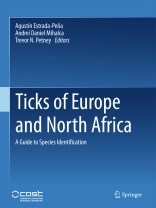This book includes descriptive keys for identifying every stage of all the species of ticks reported in Europe and northern Africa. It includes descriptive texts on the ecology and prominent features of each species, together with ink illustrations and distribution maps of more than 60 species of hard and soft ticks. The text for each species was prepared by specialists, the illustrations were made especially for this book and the maps were compiled on the basis of more than 40 years of records. This book is the first to offer keys for more than 60 species of ticks (both immature and adult) in the target territory. It also includes supplementary information with bibliographical details for each species.
This book is based upon work from COST Action TD1303, supported by COST (European Cooperation in Science and Technology)Jadual kandungan
1. An introduction on tick accepted names and nomenclature.- 2. Keys for the genera of ticks, including larvae, nymphs and adults.- 3. Keys for the genus Argas (adults and larvae).- 4. The genus Argas, including A. persicus, A. reflexus, A. vespertilionis, A. miniatus, A. polonicus, A. transgariepinus.- 5. Keys for the genus Ornithodoros (adults and larvae).- 6. The genus Ornithodoros, including the O. erraticus complex, O. maritimus, O. coniceps, O. capensis, O. alactagalis, O. lahorensis, O. tholozani. Gad Baneth and Gabriela Kleinerman.- 7. Keys for the genus Ixodes (adults, nymphs and larvae).- 8. The genus Ixodes including I. ricinus, I. hexagonus, I. canisuga, I. rugicollis, I. arboricola, I. frontalis, I. eldaricus, I gibbosus, I. ventalloi, I. laguri, I. trianguliceps, I. acuminatus, I. lividus, I. simplex, I. vespertilionis, I. uriae, I. persulcatus, I. ariadnae, I. unicavatus, and I. rotschildi.- 9. The genus Ixodes: additional information as a list of previous publications with morphological information where readers can find extra data.- 10. Keys for the genus Haemaphysalis (adults, nymphs and larvae).- 11. The genus Haemaphysalis: illustrations, additional information and maps of distribution for the species. The species to be included as illustrations and maps are: H. punctata, H. sulcata, H. inermis, H. concinna, H. hispanica, H. parva, H. caucasica, H. erinacei. Margarida Santos-Silva, Trevor Petney, Miriam Pfäffle, Thomas G.T. Jaensosn, Zati Vatansever.- 12. The genus Haemaphysalis: additional information as a list of previous publications with morphological information where readers can find extra data.- 13. Keys for the genus Hyalomma (adults, nymphs and larvae).- 14. The genus Hyalomma including H. marginatum, H. rufipes, H. lusitanicum, H. scupense, H. anatolicum, H. excavatum, H. dromedarii, H. asiaticum, H. impeltatum and H. aegyptium.- 15. The genus Hyalomma: additional information as a list of previous publications with morphological information where readers can find extra data.- 16. Keys for the genus Dermacentor (adults, nymphs and larvae).- 17. The genus Dermacentor including D. marginatus and D. reticulatus.- 18. The genus Dermacentor: additional information as a list of previous publications with morphological information where readers can find extra data.- 19. Keys for the genus Rhipicephalus (adults, nymphs and larvae).- 20. The genus Rhipicephalus including R. sanguineus sensu lato, R. turanicus, R. rossicus, R. pusillus, R. bursa, R. guilhoni and R. annulatus. Gianluca d’Amico, Trevor Petney, Miriam Pfäffle, Margarida Santos-Silva.- 21. The genus Rhipicephalus: additional information as a list of previous publications with morphological information where readers can find extra data.- 22. How to collect ticks from the vegetation, and how to interpret these collections.- 23. How to design and address collections from hosts, and how to interpret these collections.
Mengenai Pengarang
Agustin Estrada-Peña is a Professor of Zoonoses at the University of Zaragoza (Spain). His main field of research is the epidemiology of ticks and tick-borne pathogens, capturing the dynamics of the populations of ticks in natural foci of pathogens. He has described five new species of ticks, and is the co-author of over 150 papers in prominent peer-reviewed journals. His current interest is in understanding the molecular relationships between ticks, pathogens and reservoirs. He is currently involved in several projects with the European Center for Disease Prevention and Control and other European agencies, working on ticks and related topics.
Andrei D. Mihalca DVM, Ph D is an Associate Professor of Parasitology and Parasitic Diseases at the University of Agricultural Sciences and Veterinary Medicine Cluj-Napoca, Romania and a member of the European College of Zoological Medicine (Wildlife Population Health), as well as the coordinator of the European Network for Neglected Vectors and Vector-borne Infections with research interests mainly in the field of ticks. He is involved in several projects with the European Center for Diseases Control and has published more than 70 papers in high-impact journals.
Dr. Trevor Neil Petney is a Lecturer at the Department of Ecology and Parasitology, Karlsruhe Institute of Technology. His main research interests involve the complex dynamics of host-tick-pathogen systems. He has published over 160 peer-reviewed papers and is currently a specialist editor for tick and tick-borne diseases for the International Journal for Parasitology and Systematic and Applied Parasitology.












